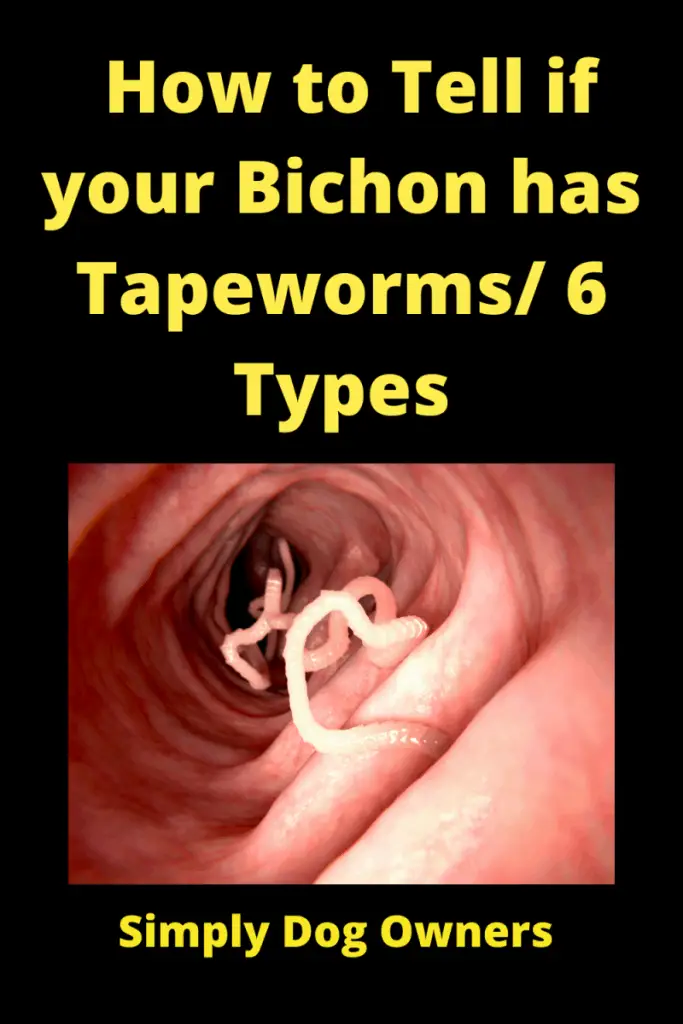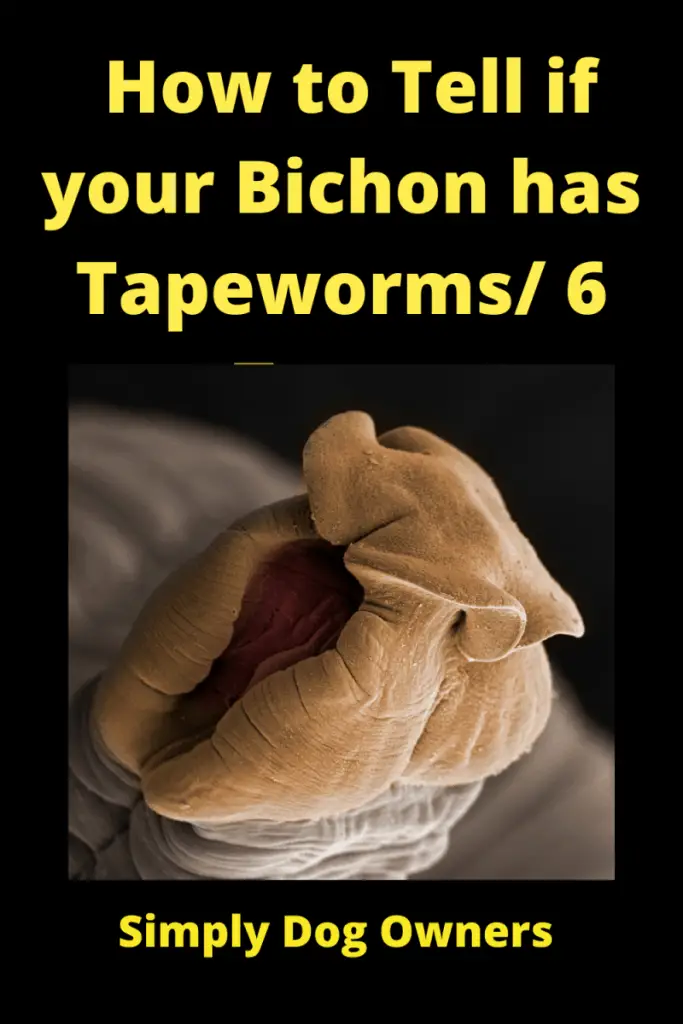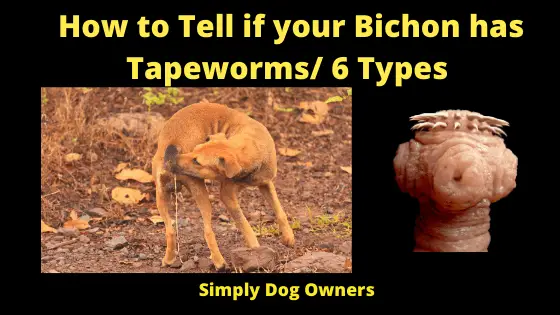Some of the symptoms to spot if your Bichon has tapeworms are as follows
- White Rice Looking Eggs in stool
- Ravenous appetite
- Thin / Skinny
- Poor Skin / Poor Hair Condition
- The emergence of tapeworms from dogs anus – then they retreat
- Diarrhea
- Scooting on its bottom
- Extension of annus trying to expel them
- Broken Pieces of Tapeworms in feces
- Bichon excessively grooming his Bottom
- Anal Itching
Introduction to Tapeworms in Bichons
The major goal of studying parasites is to protect the animal and improve its health. In this article, I will guide you for studying the tapeworms in Bichon Frise, including how to treat them, how to control them, pathogenesis, and clinical signs and diagnose the cases.
Small intestine is the predilection site for all tapeworms.
1. Diphyllobothrium Latum.
Common name: Broad Tapeworm
Pathogenesis and clinical signs: Usually asymptomatic, although occasionally vitamin B12 deficiency can occur. (Growth failure is a general symptom in vitamin B12 deficiency.) Diagnosis: This depends on the detection of the characteristic eggs in the feces. Eggs are yellow and ovoid shapes.
Pathology: Does not induce damage to the intestine.
Treatment: Praziquantel and Niclosamide are effective against adult tapeworm.
Control: In areas where the infection is common, your Bichon Frise should not be fed, fish products unless these have been thoroughly cooked or deep-frozen.
2. Dipylidium Caninum.
Common name: Double pored tapeworm or cucumber seed tapeworm.
Final host: Dog (Bichon Frise)
Intermediate host: Fleas
Pathogenesis:
The adult is non-pathogenic and several hundred can be tolerated without clinical effect. They shed segments, which as they crawl actively from the anus, may cause some discomfort and a useful sign of infection is excessive grooming of the perineum. It has been suggested that infected dogs form the habit of rubbing the anus along the floor, but impacted anal glands are a more common cause of this behavior.
Clinical Signs:
Anal discomfort and itching, Excessive grooming or licking of the perineal region, Crawling of segments from the anus.

Diagnosis:
Often the first indication of infection is the presence of a segment on the coat around the perineum. If the segment is freshly passed, preliminary identification may be made on the elongate shape, and the double genital organs, which may be seen with a hand lens. If it is dried and distorted it will be necessary to break it up with mounted needles in water, where the egg packets are easily seen under the microscope.
Treatment and Control:
- The intermediate Host of Dipylidium caninum is a flea. If your Bichon Frise ingests the infected flea, the dog may end up with an infection of this tapeworm. Therefore flea control is must be needed.
- Dog’s bedding and customary resting places should receive attention with insecticides to eliminate the immature stages of the flea, which are many times more numerous than the adult parasites feeding on the dog.
- Administration of anthelmintics, such as Nitroscanate and Praziquantel. Should be accompanied by the use of insecticides.
- Destruction of fecal matter properly.
3. Echinococcus Granulosus.
Common name: Dwarf dog tapeworm
Final host: Dog (Bichon Frise)
Intermediate host: Sheep
Pathogenesis and Clinical Signs:
The adult tapeworm is not pathogenic and thousands may be present in a dog without clinical signs. But in heavy infections there may be gastrointestinal disturbances, such as diarrhea, abdominal pain.
Diagnosis: Diagnosis of infection in Bichon Frise with adult tapeworms is difficult because the segments are small and are only shed sparsely. When found eggs in feces, identification is based on their size (2.0-3.0 mm), and ovoid shape. In some countries, control regimes have involved the administration of purgative anthelmintics, such as arecoline hydrochloride, so that the whole tapeworm is expelled in mucus and can be searched for in the feces. Immunodiagnostic tests have been developed that are based on the fecal antigen detection antibody sandwich ELISA technique.
Treatment:
More difficult to remove, but several drugs, notably praziquantel are now available, which are highly effective. After treatment it is advisable to confine dog for 48 hours to facilitate the collection and disposal of infected faeces.

Control:
This is based on the regular treatment of dogs to eliminate the adult tapeworms and on the prevention of infection in your Bichon Frise by exclusion from their diet of animal material containing hydatids (Hydatid is the development stage of Echinococcus granulosus in the intermediate host). To ensure that thoroughly cooked meat (sheep) should be given to Bichon Frise. Also denying your dog access to abattoirs, and where possible by proper disposal of sheep carcasses on farms.
4. Echinococcus Multilocularis.
Common name: Dwarf fox tapeworm
Final host: Dog (Bichon Frise)
Intermediate host: Rodents
Pathology:
The adult tapeworm causes little damage in the intestine. If your Bichon Frise eats rodents, the metacestode stage inside the rodent will enter into the dog’s liver. Invasion by the metacestode stage can result in atrophy of the liver parenchyma and cause cirrhosis.
Treatment: Can be treated with Praziquantel or Epsiprantel.
Control:
- The treatment of a dog with an effective cytocidal anthelmintic.
- Proper discard of dog feces.
- Proper sanitation and hygiene.
- Adhere to the dog deworming schedule.
5. Taenia Hydatigena.
Final host: Dog (Bichon Frise)
Intermediate host: sheep, cattle, pig
Pathogenesis and clinical signs: In heavy infections, there may be gastrointestinal disturbances, such as diarrhea, abdominal pain, and anal pruritis.
Diagnosis:
Often the first sign of tapeworm infection is the presence of proglottids (Proglottids are segments in the strobila of a tapeworm, containing a complete sexually mature reproductive system) in the faeces or more frequently the perianal area as a result of the active migration of the segments.
Treatment: Tapeworms can be removed from your Bichon Frise through the administration of an effective cytocidal anthelmintic, such as Niclosamide, Praziquantel, Nitroscanate or multiple doses of Mebendazole or Fenbendazole.
Control: Prevention of infection by exclusion from their diet of animal material containing cysts. To ensure that thoroughly cooked meat should be given to Bichon Frise.
6. Taenia Ovis
Final host: Dog (Bichon Frise)
Intermediate host: Sheep, Goat
Pathogenesis and clinical signs: Heavy infections in young Bichon Frises can cause diarrhea and ill thrift.
Diagnosis: Recognized through the presence of shed proglottids and/or tapeworm segments in fresh feces.
Treatment: Tapeworms can be removed from your Bichon Frise through the administration of an effective cytocidal anthelmintic, such as Niclosamide, Praziquantel, Nitroscanate, or multiple doses of Mebendazole or Fenbendazole.
Control: Prevention of infection by exclusion from their diet of animal material (Goat, Sheep) containing cysts. To ensure that thoroughly cooked meat should be given to Bichon Frise. Regular treatment with an effective anthelmintic will reduce contamination of the environment. The dog should be denied access to raw sheep and goat meat and carcasses. Also can give highly protective recombinant vaccine (Available in some countries)
Treating Tapeworms Naturally
- Pumpkins Seeds
- Food Grade Diatochaeaus Earth
- Grated Carrots
Top 10 Bichon Designer Breeds / Parents /Size / Video
| Designer Mix | Parents | Size | Video |
|---|---|---|---|
| Maltichon | Bichon / Maltese | Height / 8-11 inches Weight / 8 - 13 lbs | Maltichon |
| Bichpoo | Bichon / Poodle | Height / 9 - 14 inches Weight / 6 - 9 lbs | Bichpoo |
| Shichon | Bichon / Shih Tzu | Height / 9 - 12 inches Weight / 10 - 15lbs | Shichon |
| Yorkie Bichon | Bichon / Yorkie | Height / 9 - 12 inches Weight / 6 - 8 lbs | Bichon Yorkie |
| Chi Chon | Bichon / Chihuahua | Height / 8 - 10 Inches Weight / 6 - 10 Lbs | Chi Chon |
| Kashon | Bichon / Cairn Terrier | Height / 9 - 15 Inches Weight / 10 -18 Lbs | Kashon |
| Goldichon | Bichon / Golden Retriever | Height/15 - 20 inches Weight /20-40 Lbs | Goldichon |
| Chonzer | Bichon / Miniature Schnauzer | Height /10-16 inches Weight / 25-35 lbs | Chonzer |
| Glechon | Bichon / Beagle | Height /15-16 inches Weight / 15-35 lbs | Glechon |
| Corgi | Bichon / Corgi | Height /11-13 inches Weight / 31-37 lbs | Corgi |
Name - Link for Research
Parents - Breeds of Dogs
Size Height / Weight
Video - Video of the Bichon Designer Breed
Chart of Bichon Birthing Accessories
| Breeder Box | Do Not used Wired Dog cage |
| Heater | We use space heater for whole Room |
| scale | To Weigh Puppies make sure they are Gaining Weight |
| Clean towels | Chande during Birthing to clean up |
| Protected Space | Keep Mother away from other Dogs to avoid Distress |
| Draft Protection | Drafts can chill and kill a Puppy |
| Squash protection | Mothers can accidently squash a puppy |
| clean bedding | to replace after birth - will be wet |
| Seclusion | Needs her Privacy - she can get Hyper |
| Rubber Gloves | Keep things Clean and from Blood |
| Scisorrs & Thread | For Cutting Cord |
Puppy Birthing Complications
| Complications | Steps |
|---|---|
| If Unsure | Take to Vet If Time allows |
| Keep Mother Isolated | If Other dogs around she could get defensive and accidently Hurt Puppies |
| Puppy Accidentally Crushed | Make sure Not Giving Birth in Dog cage - puppies can work themselves through mesh and get Damaged |
| Not Breathing | Gently Give it Mouth to mouth |
| Not breathing | Massage Puppy trying to gently force fluid from his lungs |
| Puppy Stuck | Gently Pull |
| Puppy Breech | Help Guide legs out |
| Puppy Cold | Raise Enviorment to 85 degrees |
| Puppy Cold | Change Wet Bedding |
| Puppy Cold | Warm Puppy up put on Your body till body heat warms him |
| Puppy Cold | No drafts - No metal Floor Pan on Cage |
| Puppy not going on Nipple | Help Guide him to nipple till he gets hand of it |
| Puppy not feeding | Try Small baby Bottle let him suck - do not force him - can drown him with milk going in lungs |
| Puppy not feeding | Use puppy Milk Supplement |
| Puppy Not feeding | check for Cleft Palate |
| Puppy Not Feeding | Take to Vet - he can show you Catheter Feeding |
| Puppy Not Growing | Make sure Mother has plenty Food Water |
| Puppy Not Growing | You can check on scale |
| Labor stops or is prolonged over 24 hours | Take to vet - C section can save litter and Mother if needed |
| Mother does not Remove Membrane | You will Need to Manually remove it |
| Mother does not chew through Umbilical Cord | You will need to cut it 1/2 " away from puppies body tier with thread |
And Recommended Steps
Expense Table for Owning Bichons Frise
| Average Cost of AKC Puppy | Puppy Shots | Food | Grooming 4 / per year | Cage / Accessories / Bowls / Brushes / Leash / Collar | AKC - Registration Within 6 Months of Purchase | Micro Chip | Yearly Meds Heart Worm Worming | Dog License | Total Investment | Puppies Possible / Year |
|---|---|---|---|---|---|---|---|---|---|---|
| $ 450 - No Breeding Rights | $ 120 | $ 10 / Wk High Quality Food | $ 45 ea / $180 Yr | Cage - $50 Rest - 50 | $ 35 | $ 45 - One Time Cost By Vet | Heart Worm Meds - $60 / Yr Worming - $ 30 / YR | $ 35 / Yr | $ 1575 / Dog | 1-6 Puppies Average 3 |
| $ 750 - $ 950 Puppy with AKC Papers and No Restrictions | Total Investment | |||||||||
Breeds Descended from Water Dogs
| Name of Breed | Country of Origin |
|---|---|
| American Water Spaniel | United States |
| Barbet | France |
| Cantabrian Water Dog | Spain |
| English Water Spaniel | England |
| Irish water Spaniel | Ireland |
| Lagotto Romagnoio | Italy |
| Poodle | Germany |
| Portuguese Water Dog | Portugal |
| Pudelpointer | Germany |
| Spanish water Dog | Spain |
| Tweed water Spaniel | England |
| Wetterhoun | Netherlands |
Bichon Frise Resource Links
| Bichon Frise Club of America | United States | Link |
|---|---|---|
| Bichon Frise AKC | United States | Link |
| Bichon Frise United Kennel Club | UK | Link |
Conclusion
Preventing Tapeworm infestation is Preventable by regularly treating your Bichons for tapeworms. Our worming Meds were provided by our Vet, then we administered it to the Dogs. We were very careful to dispose of dog poop to avoid recontamination. We also cooked all meats and treated our dogs for Fleas, to help prevent problems.
